Smoked Asian Sticky Ribs Recipe and Thermal Pointers
You think you know ribs. You’ve cooked spare ribs, baby backs, beef short ribs. They’ve all been fun, they’ve all been delicious. But your rib repertoire is woefully incomplete if you haven’t made these sticky-sweet, glazed, Asian-scented ribs. This recipe from Hey Grill Hey is super tasty and absolutely worth talking about.
Contents
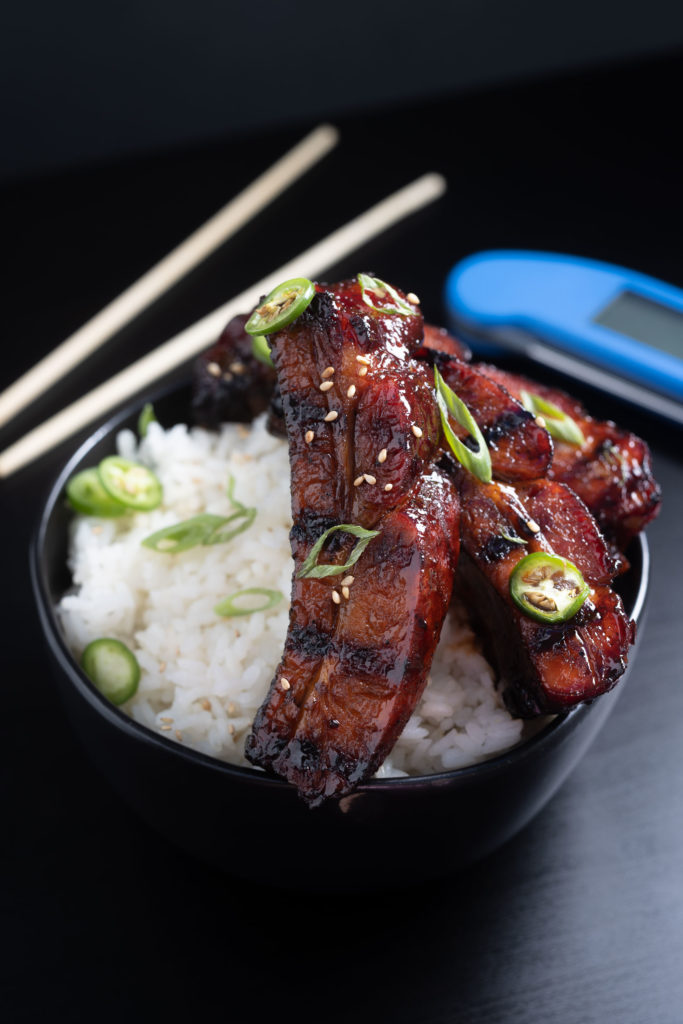
Baby back rib basics
Contrary to popular myth, baby back ribs are not from baby pigs. They are called baby backs because they are smaller than the longer spare ribs. They are more accurately called back ribs, which describes the location on the hog from whence they are butchered. These ribs would, if allowed to remain with their neighbors, be the bones of a bone-in pork loin roast. This proximity to a meaty loin explains the thicker top layer of meat on back ribs: when they are butchered out, some of the meat from the loin connection remains on the ribs. Yum!
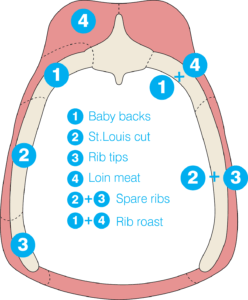
Cooking baby back ribs is basically just like cooking other ribs, but with a little less time involved. You need to dissolve the tough collagen that binds the ribs together, and that means low, slow cooking. Collagen, which is a tightly bound protein fiber, doesn’t start to unwind until its temperature reaches about 165°F (74°C), and the unwinding process speeds up the hotter it gets beyond that. (This means that collagen dissolution is a function of both time and temperature.) The target temperature for ribs is the same as that for most non-fowl barbecue: 203°F (95°C). A Smoke X2™ dual-channel thermometer is a great way of monitoring both the ribs and the smoker temperature while they cook to assure that you nail those target temperatures. (Verify the finish temp with your Thermapen® ONE, of course!)By the time the meat in baby back ribs reaches this temperature, it has had enough time in the collagen-melt zone to have become tender. And the resulting by-products of the unraveling—gelatin and water—will have filled the meat with their tasty, juicy goodness.
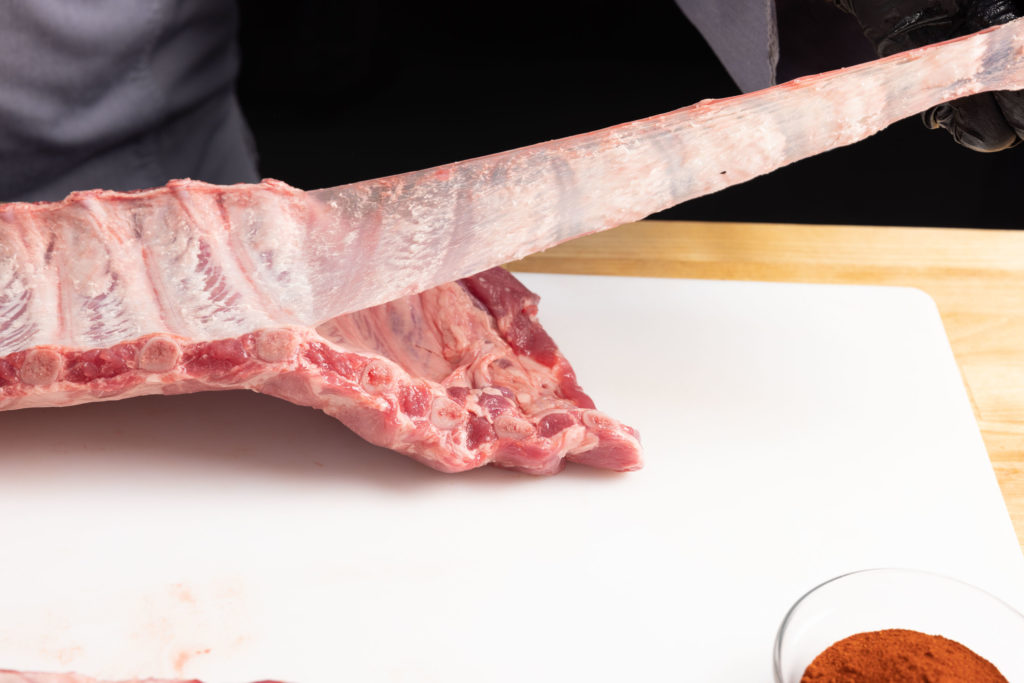
So much should already be pretty clear to the usual reader of this blog, but these particular ribs are going to take a turn that other ribs we have cooked have not taken. They will have a braising step.
BBQ braising
Braising means cooking in a relatively small amount of liquid, usually at relatively low heat. In the case of these ribs, you’ll be using a braising liquid based on soy sauce, juice, and hoisin.
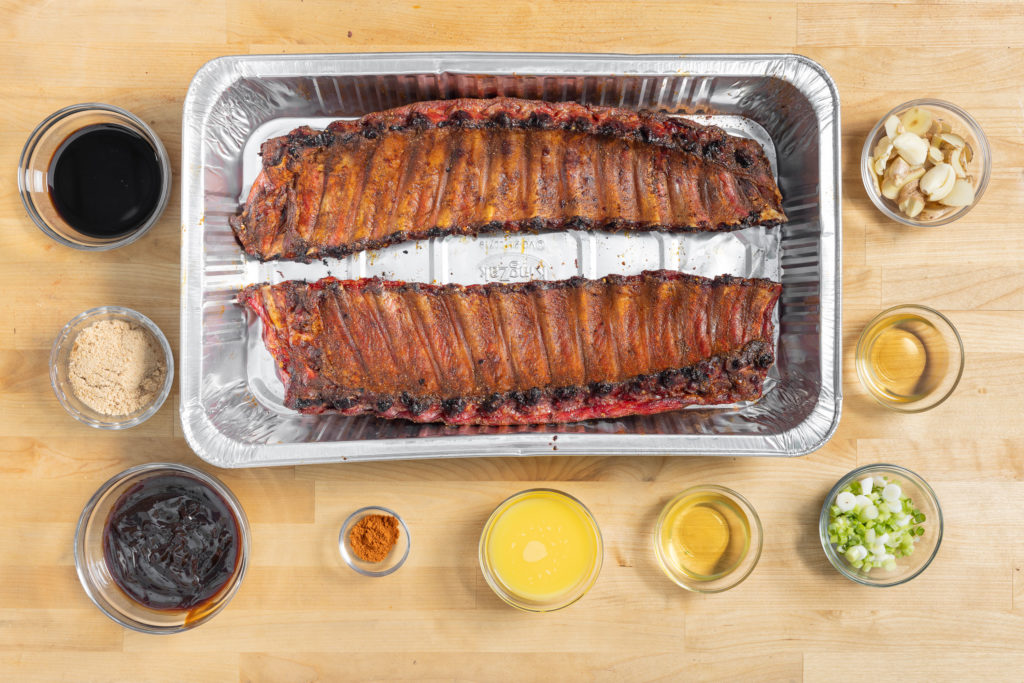
Some of you may be complaining right now that this is ‘inauthentic’ BBQ, that it isn’t smoked the whole time. Well, if that’s what ‘authentic’ means, then no, it isn’t. But consider this: after the first few hours of cooking, there is no more smoke penetration into smoked food. The depth of that smoke ring is the depth of the smoke. So why not take the ribs off the smoker once they’ve reached maximum smoke saturation and cook them tender a little faster, a little tastier?
Braising and the rub
Will braising destroy the bark of the ribs? Answer: not really. By the time your bark is established, it has bound with proteins that have been leaking out of your met. These are, in a very literal sense, glue, and can hold the bark quite well. Will a little seasoning be lost to the liquid? Of course. But you will still have plenty of savory flavors to go around.
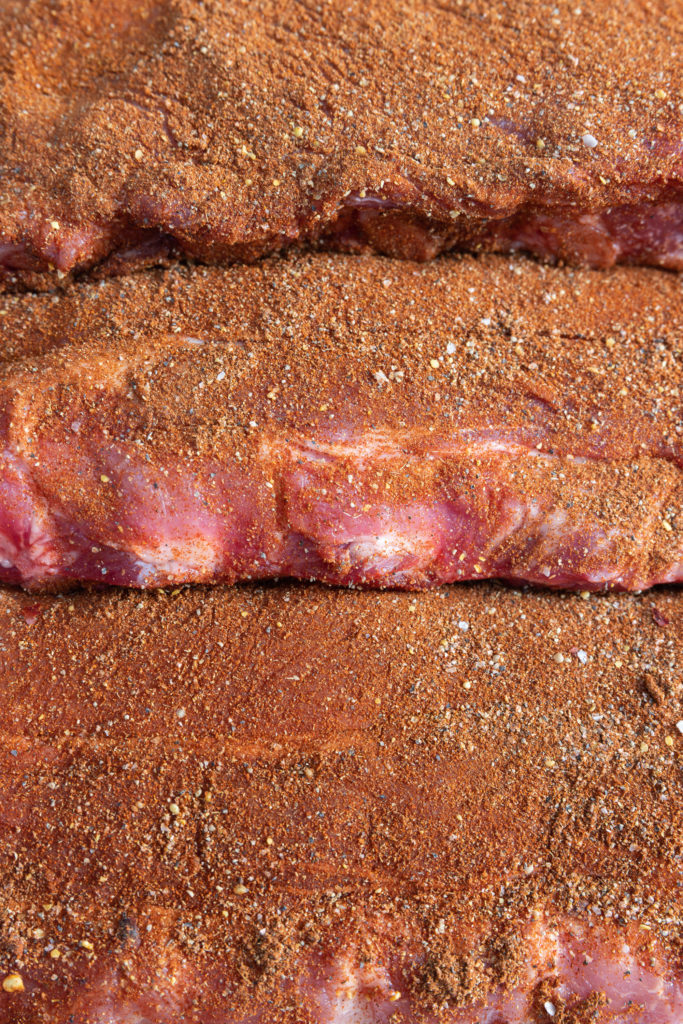
Braising basics
We recently wrote about the science of braising on this blog, but a little review won’t hurt anything.
Braising is a process by which a little liquid is used to quickly and efficiently break down the collagen in tough foods. The use of a water-based medium increases the efficiency of a braise because of water’s high heat capacity. That means that the braising liquid can pump more heat into your meat faster than, say, hot air can. And that means faster collagen dissolution.
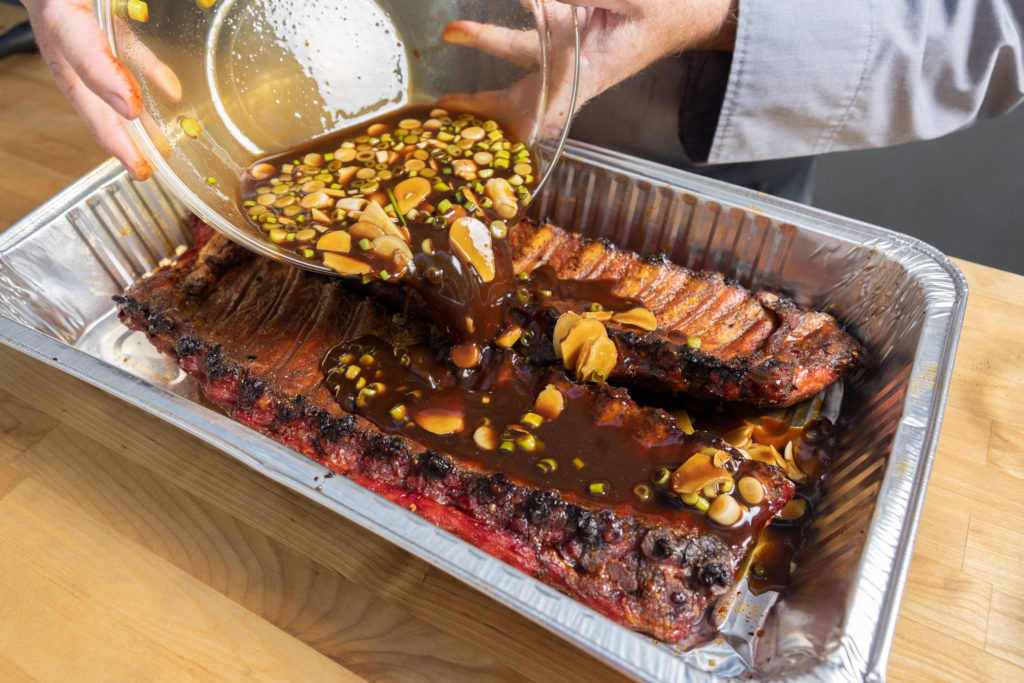
In this case, we’ll be cooking these ribs in a strongly flavored bath based on soy sauce. This braising liquid will help to soften the ribs while simultaneously imparting deep, delicious flavors.
Caramelization
So you have a bark, and you’ve both softened the meat and imparted flavor in a braise. But whence the stickiness? The stickiness of these ribs comes from a glaze made of the braising liquid—rich in gelatin and all the other good things you added to it—combined with some other jelly and some vinegar. The jelly adds sugar for caramelization, as well as pectin for sticky-making, and the vinegar levels out the sweetness and wakes up the flavors.
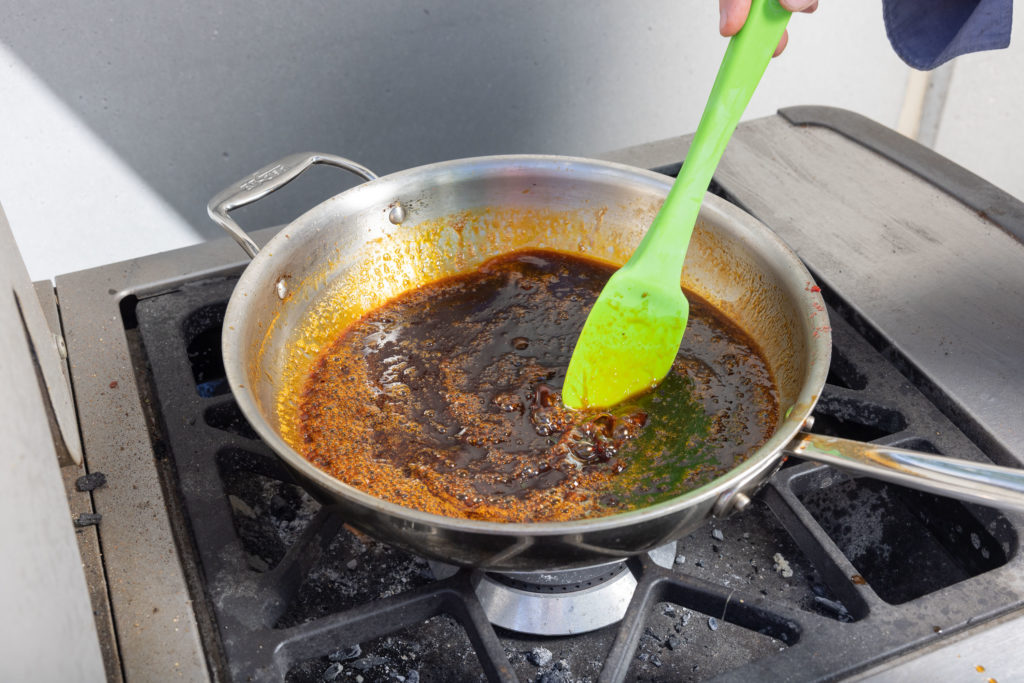
Reduce this glaze to concentrate the sugars and shorten the time needed on the grill to caramelize. Thickening the sauce prevents the ribs from drying out and overcooking while you’re trying to get that sticky, lacquer-like finish on them. Dunk the ribs in the sauce, grill, and baste with more sauce. Yum.
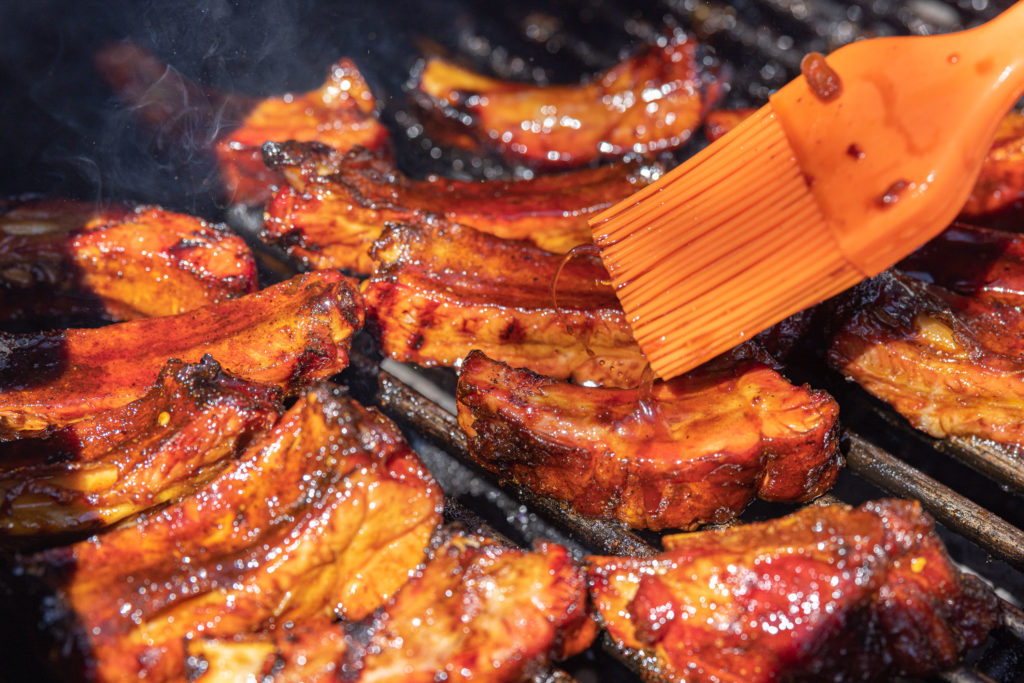
These ribs will go fast. The sticky, sweet-spicy glaze and the tenderness of the meat will guarantee that only a pile of bones will be left in no time at all. And with the assurance you get from your Smoke X2™ thermometer that the ribs are, in fact, cooked properly, you can serve these to cookout guests with confidence and pride. They’ll thank you for it!
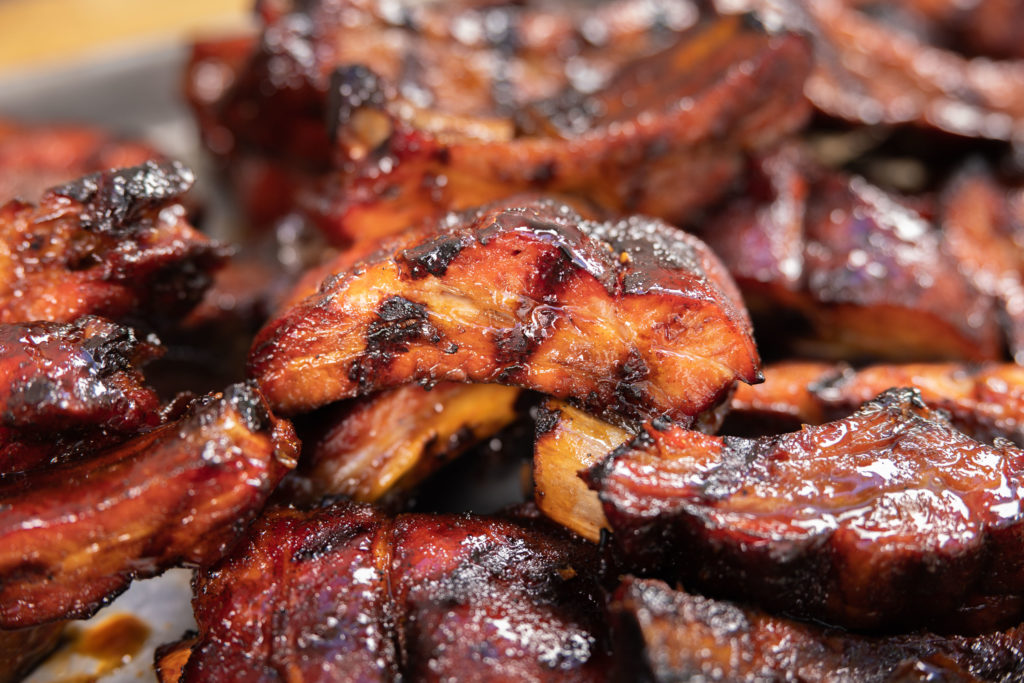
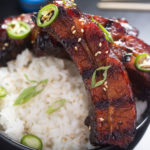
Smoked Asian Sticky Ribs Recipe
Description
Smoked Asian Sticky Ribs, adapted from HeyGrillHey.com
Ingredients
- 2 racks of baby back ribs
Asian-Style BBQ Rub
- 4 Tbsp smoked paprika
- 1 Tbsp Chinese 5 spice powder
- 1 Tbsp ground ginger
- 1 tsp ground mustard
- 2 tsp Kosher salt
- 1 1/2 tsp ground pepper
- 1 1/2 tsp ground allspice
- 1/2 tsp crushed red pepper flakes
Braising Liquid
- 1 C hoisin sauce
- 1/2 C soy sauce
- 1/2 C orange juice
- 1/2 C brown sugar
- 1/4 C rice wine vinegar
- 1/4 C white grape juice or apple juice
- 4 cloves garlic crushed
- 3-inch fresh ginger root, peeled and sliced
- 6 scallion whites, diced
- 1 tsp cayenne powder
Sticky BBQ Sauce
- 10 oz red pepper jelly
- 1/2 C apple cider vinegar
Garnishes
- sesame seeds to taste
- 6 scallion greens cut on a diagonal
- 1–2 fresh serrano peppers, sliced into thin coins (optional, but highly recommended!)
Instructions
- Preheat your smoker to 250°F (121°C). Use your Smoke X2 to set high- and low-temp alarms on either side of your target temperature to make sure you keep smoking at the right temp.
- Combine ingredients for the rub in a bowl.
- Prepare the ribs by removing the membrane from the back.
- Coat the ribs all over with the rub.
- Place the ribs in the smoker and smoke for 2 hours (set the time on a big, loud timer so you don’t miss the alarm). We’re monitoring the meat and air temps with a Smoke thermometer. Set the high air alarm to 275°F (135°C), low alarm at 225°F (107°C). Set the meat high alarm for 175°F (79°C)—that’s not a pull temp, we just want to monitor it and make sure it doesn’t get too hot during the cook.
- When time is almost up, combine the ingredients for the braising liquid.
- Remove the ribs from heat and place meat-side-down in an aluminum pan.
- Increase the heat in your smoker to 325°F (163°C).
- Pour braising liquid into the pan, being sure that some gets on the backs of the ribs.
- Insert a thermometer probe into the ribs between the bones.
- Cover the pan tightly with aluminum foil.
- Place the pan in the smoker and cook.
- Set the high alarm on your Smoke’s meat channel to 203°F (95°C). Set the air-temp channel alarm with a range from 300°F (149°C) to 350°F (177°C).
- Cook until the alarm sounds and the ribs are at temperature and the alarm sounds, about another 2-3 hours. Verify the ribs’ temperature with your Thermapen ONE.
- Once the high-temp alarm sounds for the ribs, remove the pan from heat.
- Remove the ribs to a cutting board.
- In a saucepan, mix the ingredients for the sticky BBQ sauce with the braising liquid.
- Boil the BBQ sauce until reduced by 1/3.
- Heat your smoker to 450°F (232°C) or fire up your grill, and set up for direct cooking.
- Cut the ribs apart with a sharp knife.
- Dip each rib in the thickened BBQ sauce and place on the grill grate to caramelize.
- Turn each rib so that the sides get equally sticky.
- Remove ribs from the grill. Garnish with sesame seeds and sliced scallions and chilies.
Shop now for products used in this post:


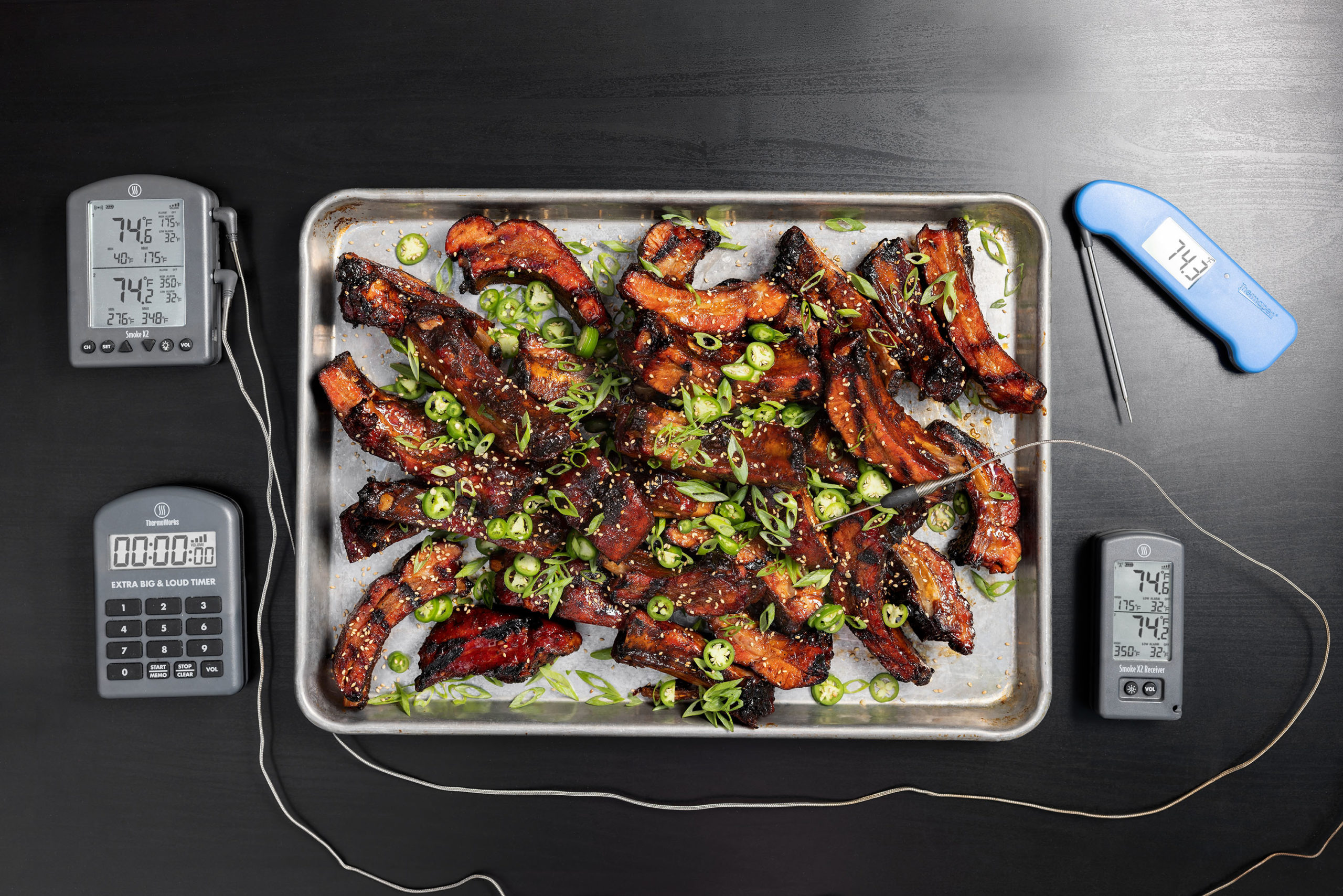
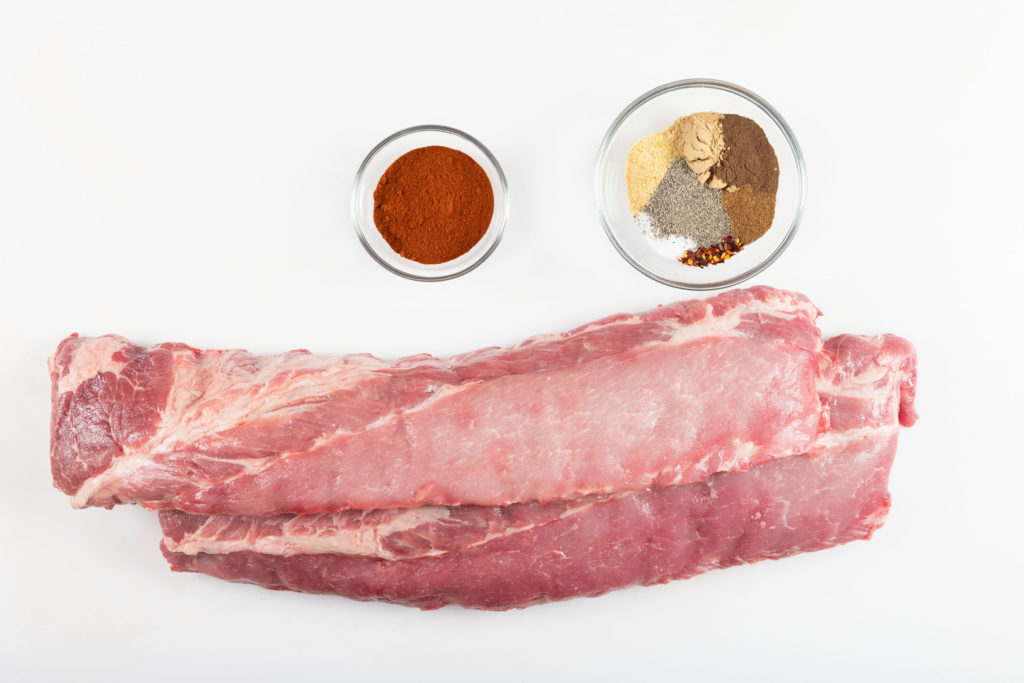
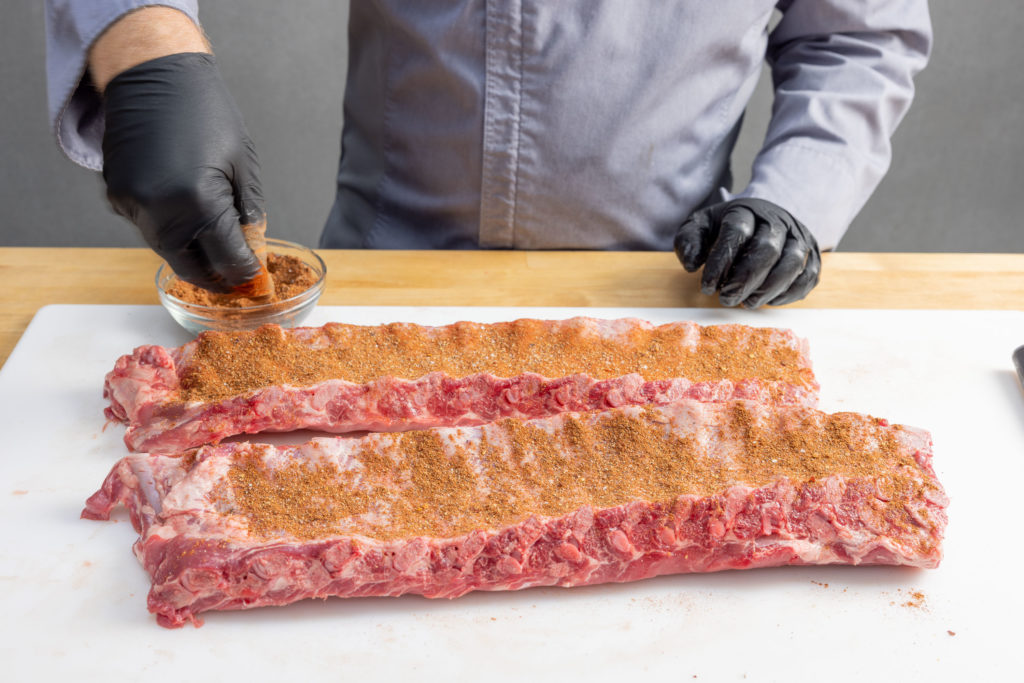
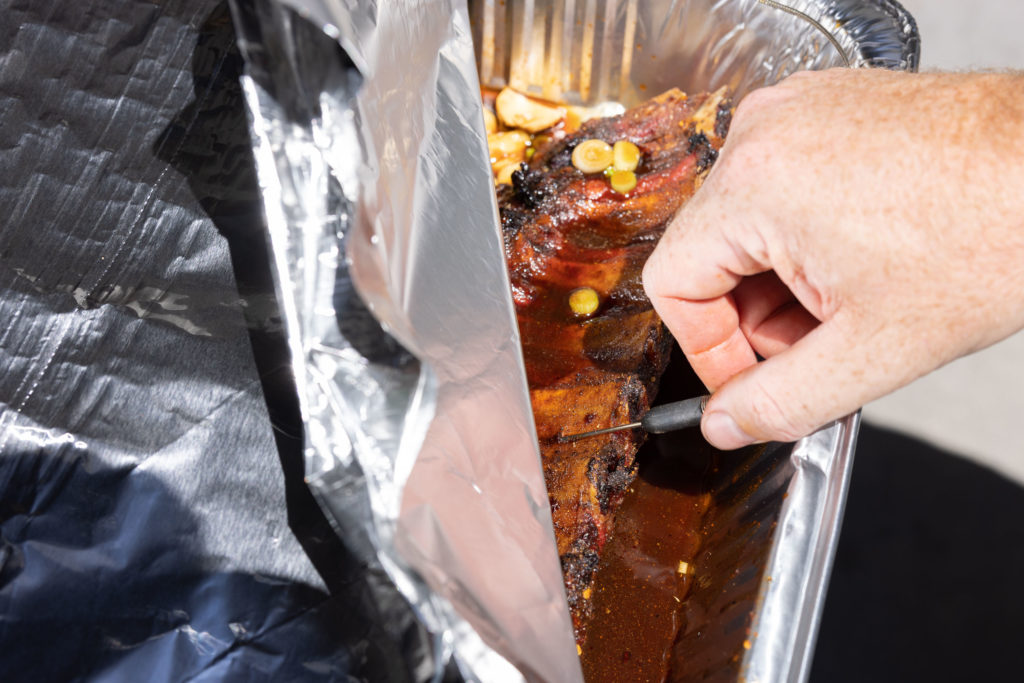
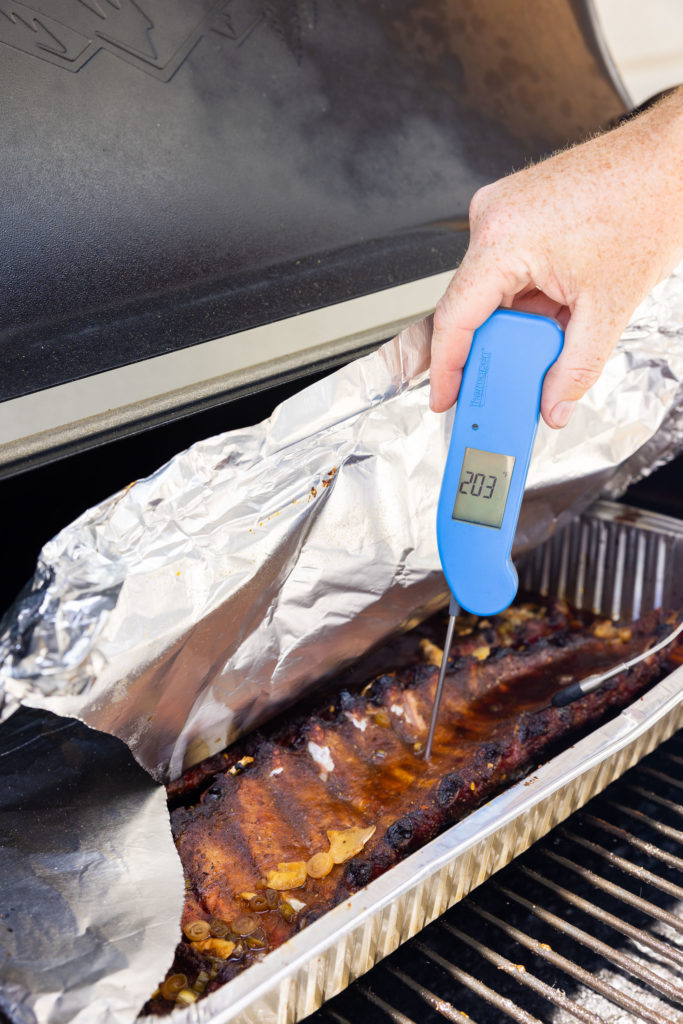
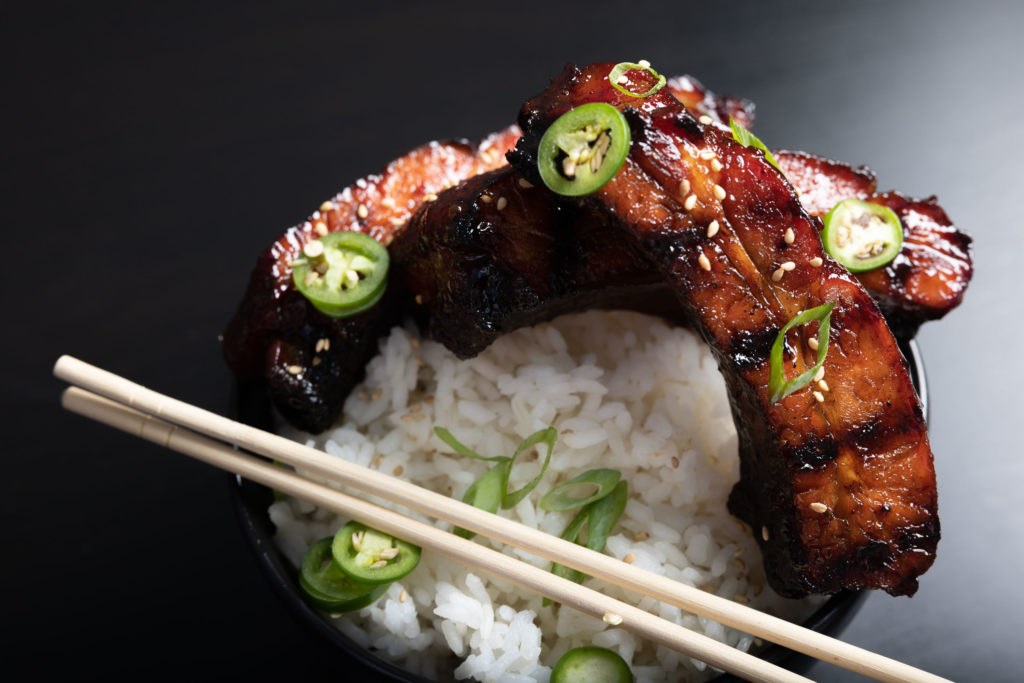


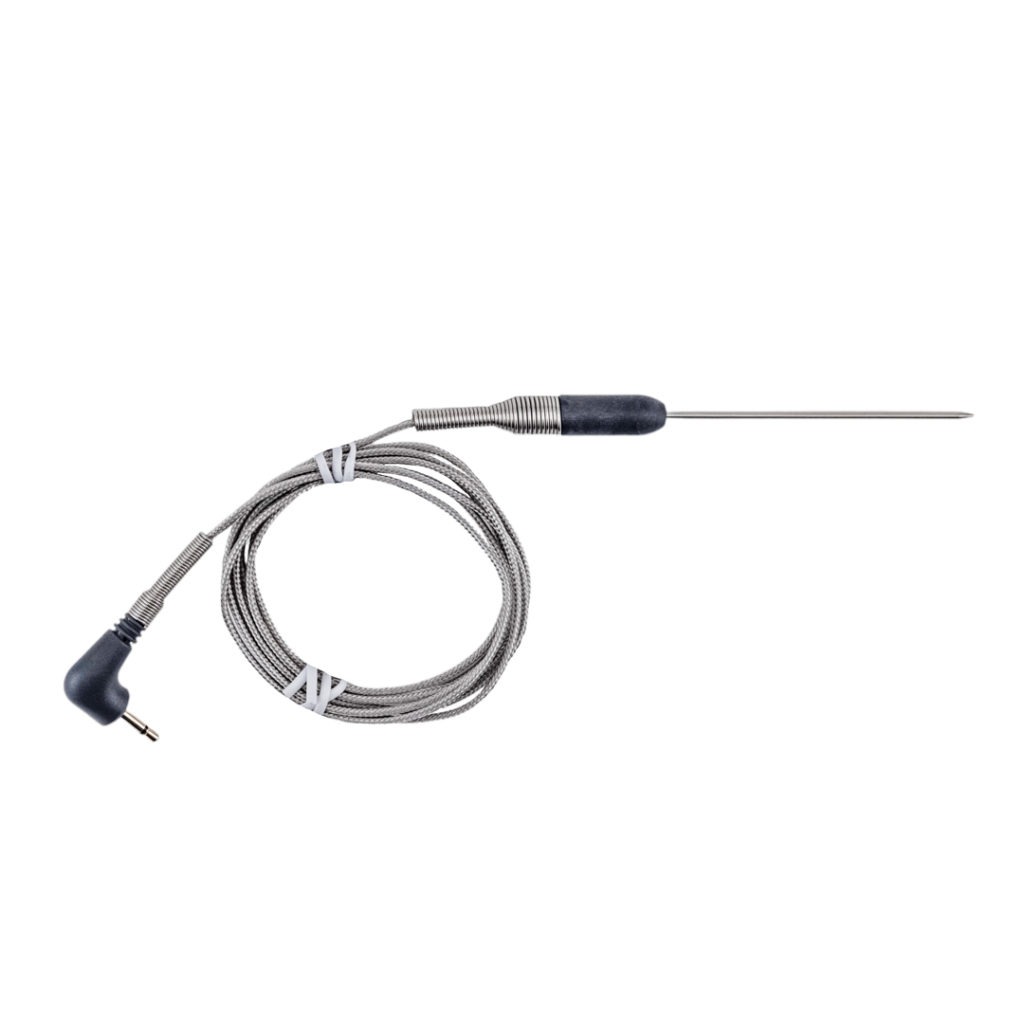
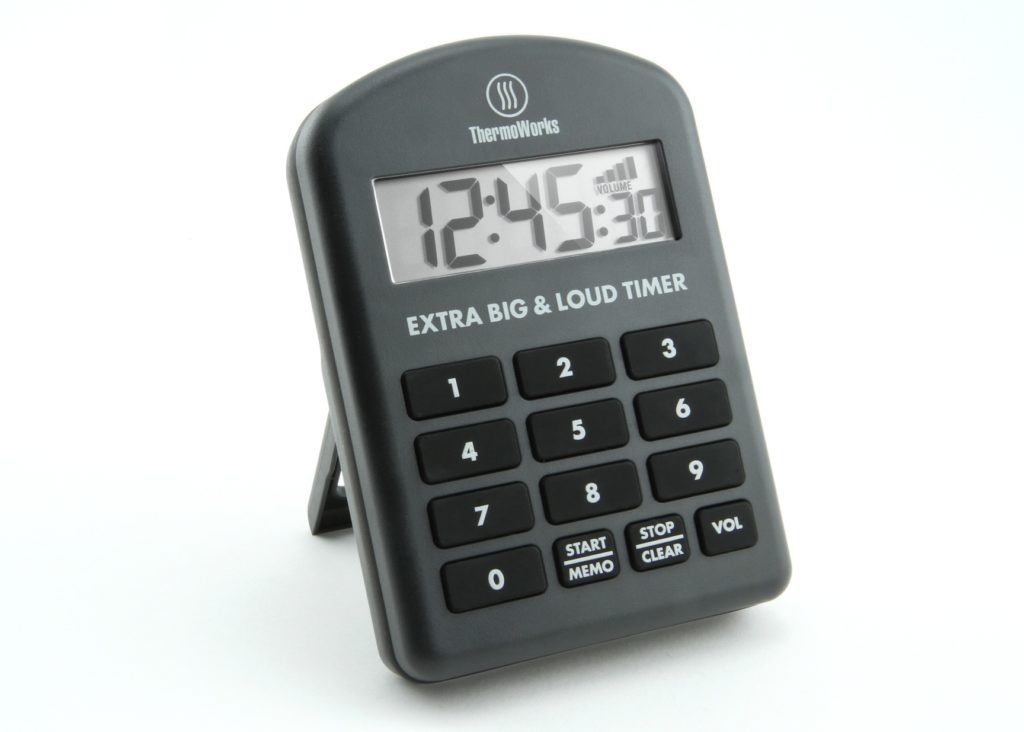
I’ve often wondered if this can be done in reverse. Braise then smoke. Does the smoke not penetrate into cooked food? I ask because if I can use the smoker to dry out the surface a bit and then glaze in the smoker after I heat it up then it sort of eliminates a step.
Ken,
Interesting concept. I suppose you could, but you will not get a smoke ring. That comes from the chemicals in the smoke changing the pigments so that they don’t turn brown. If you pre-braise, they will already be brown, so there will be no visual indication of smoke.
A problem will also be bark creation. Smoking the ribs dry allows the bark to bind with the proteins on the surface to form a ‘permanent’ coating. That won’t happen with a preliminary braise. The glaze will work, but it take s good long smoke to get that bark set up.
Which kind of Red Pepper Jelly: Red Bell Peppers or (Asian style)Hot Pepper Jelly?
I assume the latter.
Thanks
Mike,
Use whatever kind you want. I like something spicier, a cayenne or jalapeño jelly, but a red pepper will taste great, too!
Try the Red Pepper Jelly made by Texas Pepper Jelly – they have several flavors and they are all off the hook good!
What kind of wood was used? I assume hickory
Gary,
We used apple in this cook. Hickory would be delicious too, but I personally like apple for almost all pork.
I do a lot of Chinese cooking. There are a couple things in the recipe that do not belong at all. One is paprika. No Chinese recipe ever uses paprika. Apple cider vinegar doesn’t belong either, nor does red pepper jelly. Chinese BBQ gets its “stickyness” from Maltose, and if maltose is unavailable, the substitute is honey. Here is a much better recipe for Chinese Ribs. https://thewoksoflife.com/chinese-bbq-pork-cha-siu/#recipe
These were never meant to be authentically Chinese, but to be ribs with flavors rooted a couple Asian cuisines, melded with American BBQ flavors and techniques. But that recipe looks great, too!
If you’re braising the ribs in a sealed aluminum pan, why bother using a smoker? Maybe you could get a little smoke on the ribs during the last step (though at 450 degrees, there’s just not a lot of smoke produced).
The first step of smoking imbues them with smoke flavor. Yes, you could do the braising step in a pan in the oven, if you like.
I will try this on my next cook. Sounds delicious.
A lot of sugar , hoisin , O.J. , Grape juice , brown sugar . Leave out brown sugar , taste braising liquid for sweetness , add brown sugar after taste if needed . smoker : 225 2 hrs , braise @ 250 1 hr , ribs had nice bite , 2 hrs @ 325 would have been to much . Cooked on Rec Tec 590 .
Pretty darn TASTY!! Will 100% be doing these again. They were a hit. I used Apricot marmalade and added a large spoonful of Calabrian ground pepper to the mix. I reduced the sauce a bit much so dunking the 1st rack of ribs into the sauce prior to Carmelizing used up A LOT of sauce and so had to be conservative with next rack. BUT man what a great favorable and DIFFERENT bbq cook. Loved it.
I always pay attention to recipes from thermoworks. Being a foodie, always have to take a look. These ribs looked spectacular, in the pictures. I read the recipe over and seen it was involved. I ordered ingredients, that I was missing, from Amazon. I even chose to heat and grind, to make my own Chinese 5 spice powder. To say that they turned out incredible, would be an understatement. They have ruined me for regular ribs. So many flavors, in this recipe, and then the sticky gooey bbq sauce, puts them way over the top, leaving the laquer finish, and a light crunch to them. I used an All clad roaster, for braising, and they reached temperature, after only 75 minutes. I pulled them out of the oven, and temped them, and trusted my thermapen, and went to the next step. Dont miss out on these.
I love that you made your own 5-spice powder, even! And I’m so happy you loved them. We are always looking for an excuse to re-make them here at the office. Happy cooking!